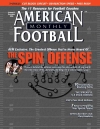AMERICAN FOOTBALL MONTHLY THE #1 RESOURCE FOR FOOTBALL COACHES
Article CategoriesAFM Magazine
|
Playing it Safe in The Red Zoneby: Travis NiekampLinebackers Coach Eastern Washington University © More from this issue Keep it simple. The Cardinal Rule, no only for life in general, but also for football. It is a philosophy you may want to adopt to play better defense in the Red Zone. There is no question that the Red Zone is the most important zone on the field. Good Red Zone defense wins games! Typically on defense it is the most aggressive section of your game play; it quickly can become a high risk / high reward zone. However, I want to explain why you should keep it low risk and improve by playing it safe. As offensives approach goal lines, defensive coaches feel they must roll the dice and take more chances to get a stop or make a play. As a result you tend to see big plays by the opposite side of the ball for touchdowns. With a short field the advantage goes to the defense; there ....The full article can only be seen by subscribers. Subscribe today!
|
|
|||||||
| HOME |
MAGAZINE |
SUBSCRIBE | ONLINE COLUMNISTS | COACHING VIDEOS |
Copyright 2025, AmericanFootballMonthly.com
All Rights Reserved





